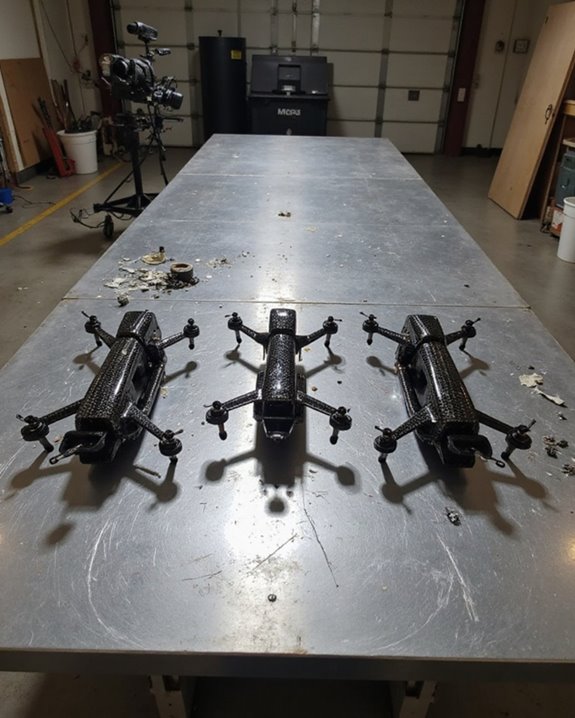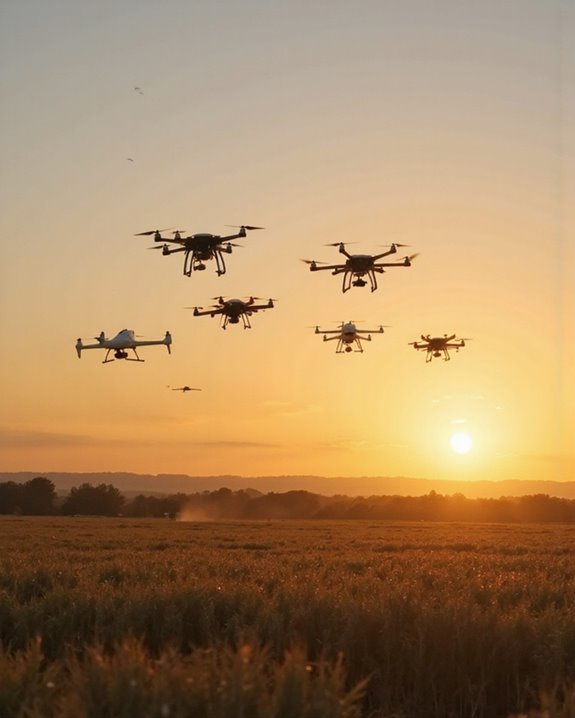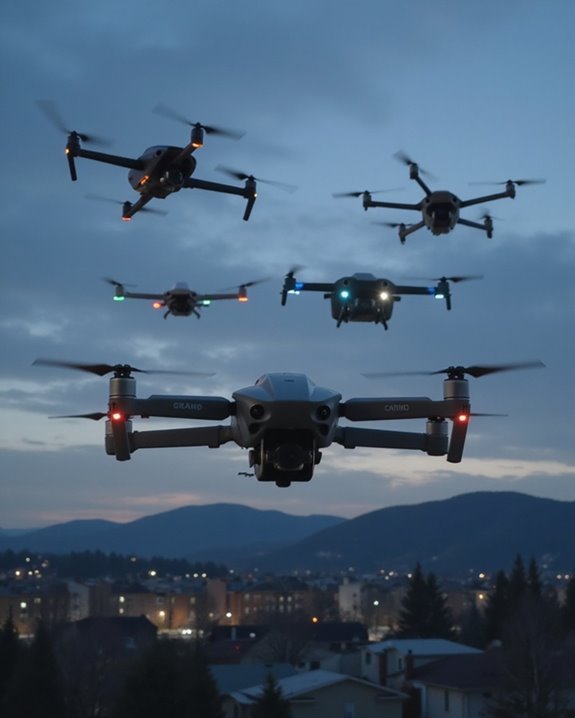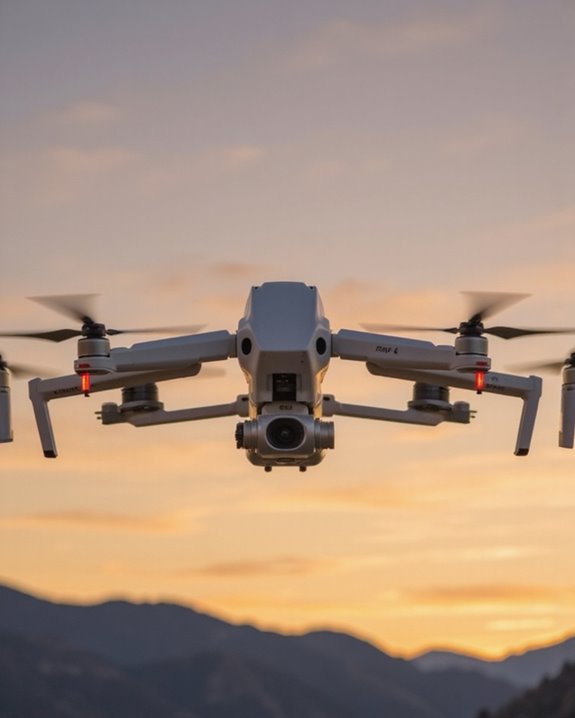Based on extensive crash testing, you’ll find three exceptional frames that dominate the 2025 durability rankings! The carbon fiber Readytosky S500 leads the pack with its DJI-inspired arms and pre-soldered PCB, while the glass fiber F450 showcases incredible concrete impact resistance. The HAWK’S WORK F450 rounds out the top three with its educational-friendly design and 1.8kg payload capacity. These battle-tested frames offer the perfect blend of toughness and versatility – let’s explore why they’re crushing the competition.
Key Takeaways
- The F450 Frame Kit demonstrates superior durability with its glass fiber polyamide nylon construction, surviving multiple concrete impacts without structural damage.
- Readytosky S500’s carbon fiber construction and crash-resistant arms make it ideal for professional users requiring both strength and lightweight design.
- HAWK’S WORK F450 excels in educational settings with its 1.8kg payload capacity and sturdy build that withstands frequent learning-related crashes.
- Pre-threaded brass sleeves and integrated PCB boards across all three frames significantly reduce damage from vibration and improve long-term reliability.
- Frame weights between 300-500 grams provide optimal balance between durability and agility, with the F450 being lightest at 395 grams.
Readytosky S500 Quadcopter Frame Kit for FPV Drone
- ★ S500 is the quadcopter frame for upgrade F450 FPV Frame Kit.
- ★High quality PCB version carbon fiber material and exquisite design.
- ★PCB Center plate with solder point ,good qiality carbon fiber landing gear;
For DIY drone enthusiasts and FPV pilots looking to upgrade from basic frames, the Readytosky S500 stands out as a compelling carbon fiber option. You’ll find solid construction with pre-soldered PCB boards and crash-resistant arms that’ll handle your ambitious flights with style.
While the frame’s 16-ounce weight keeps it stable in winds, you’ll want to upgrade those landing legs – they’re the kit’s Achilles’ heel! The frame supports GoPro setups beautifully with its 2-axis gimbal mount, and you’ll love how the enhanced arm design borrows from DJI’s legendary S800 EVO. Just remember to add some thread locker to those screws, and you’re ready for countless hours of FPV adventures.
Best For: DIY drone builders and FPV enthusiasts seeking a durable, mid-level carbon fiber frame that can support GoPro cameras and offers room for customization.
Pros:
- Strong carbon fiber construction with crash-resistant arms inspired by DJI S800 EVO design
- Pre-soldered PCB board simplifies assembly and wiring
- Versatile platform supporting GoPro cameras with 2-axis gimbal compatibility
Cons:
- Weak landing legs prone to breaking upon impact
- Center PCB board tends to be flimsy and can snap
- Requires additional modifications and thread locker for optimal performance
F450 Drone Frame Kit 4-Axis Quadcopter (450mm)
- ★Ultra high strength material: Built from quality glass fiber and polyamide nylon.It is stable to falling and impact.
- ★Integrated PCB connections for direct soldering of your ESCs, make your esc,power supply and other wiring more quickly and reliable.
- ★Pre-threaded brass sleeves for all of the frame bolts.Colored arms for orientation to keep you flying in the right direction.
Intermediate pilots seeking a reliable and durable quadcopter frame will find their perfect match in the F450 4-Axis Kit. Built from glass fiber polyamide nylon, this 395-gram workhorse has survived countless crashes onto concrete while keeping your precious components intact!
You’ll love the frame’s thoughtful design features, including pre-threaded brass sleeves, integrated PCB power distribution, and color-coded arms for easy orientation. While the landing gear may be a bit flimsy, the core frame is rock-solid for mounting your favorite flight controller, from the Airbot OmniBus F4 Pro to the Mateksys F405-STD. At just 312g without legs, it’s the perfect balance of durability and weight for your next build.
Best For: Intermediate drone builders looking for a reliable, crash-resistant frame for custom quadcopter projects that can accommodate various flight controllers and components.
Pros:
- Extremely durable glass fiber polyamide nylon construction that withstands impacts and crashes
- Well-designed features including integrated PCB connections, pre-threaded brass sleeves, and color-coded arms
- Versatile mounting options for different flight controllers and components with good quality core frame parts
Cons:
- Flimsy landing gear that tends to bend upon impact
- Some arms may require trimming of molding flash with a hobby knife
- Slightly heavier than some comparable frames at 395 grams with all components
HAWK’S WORK F450 Drone Frame Kit (450mm Wheelbase)
- 𝐘𝐨𝐮𝐫 𝟏𝐬𝐭 𝐃𝐈𝐘 𝐃𝐫𝐨𝐧𝐞 𝐅𝐫𝐚𝐦𝐞 - F450 is the best educational quadcopter drone frame for both beginners to learn the...
- 𝐌𝐨𝐫𝐞 𝐂𝐚𝐩𝐚𝐜𝐢𝐭𝐲 & 𝐌𝐨𝐫𝐞 𝐒𝐩𝐚𝐜𝐞 - Wheelbase: 450mm, Maximum take-off weight: approx. 1.8kg. It has enough space...
- 𝐔𝐥𝐭𝐫𝐚 𝐇𝐢𝐠𝐡 𝐒𝐭𝐫𝐞𝐧𝐠𝐭𝐡 𝐌𝐚𝐭𝐞𝐫𝐢𝐚𝐥 - Made of quality glass fiber and polyamide nylon, the frame is...
The HAWK’S WORK F450 stands out as a perfect educational frame that’ll make both beginners and experts smile! You’ll love how this versatile 450mm wheelbase frame combines durability with user-friendly features, including pre-threaded brass sleeves that make assembly a breeze.
The built-in PCB board with soldering options for ESCs will save you from wrestling with complex wiring – no more spaghetti mess in your build! Made from glass fiber and polyamide nylon, this lightweight yet sturdy frame can handle those inevitable learning curves without breaking a sweat. With a generous 1.8kg maximum takeoff weight and plenty of space for your Raspberry Pi and sensors, you’re getting a reliable platform that grows with your skills.
Best For: Perfect for drone beginners and educational institutions looking for a durable, easy-to-assemble quadcopter frame that offers room for learning and experimentation.
Pros:
- Built-in PCB board with pre-soldering options simplifies wiring and assembly
- Durable glass fiber and nylon construction can withstand learning crashes
- Generous 1.8kg payload capacity with ample space for additional components
Cons:
- 450mm wheelbase may be too large for indoor flying
- Pre-soldered version costs more than standard option
- Basic frame kit requires additional components to complete build
Factors to Consider When Choosing a Drone Frame

When you’re ready to select your perfect drone frame, you’ll need to look at several key factors that can make or break your flying experience! From lightweight carbon fiber to durable aluminum alloys, your choice of frame material will affect everything from flight time to crash survival, while the frame’s size and mounting options determine what components you can use. Before pulling out your wallet, you’ll want to carefully weigh the frame’s strength-to-cost ratio and consider whether you’re up for a complex build or prefer something more straightforward.
Frame Material and Durability
Choosing your drone frame’s material deserves careful consideration since it’ll directly impact your flying experience and investment longevity. You’ll want to pay attention to modern materials like carbon fiber and glass-fiber-reinforced polyamide nylon – they’re absolute game-changers in the durability department!
These lightweight champions typically weigh between 300-500 grams, giving you that sweet spot between agility and toughness. Think of them as your drone’s armor – they’ll take those inevitable bumps and crashes like a champ! The best frames now come with clever features like pre-threaded components, making them both reliable and maintenance-friendly. When you’re zipping through obstacles or attempting those tricky maneuvers, you’ll appreciate how these materials resist vibrations and maintain their structural integrity. Trust us, your future self will thank you for investing in quality frame materials!
Weight and Size Specifications
Proper weight and size specifications serve as critical pillars in your quest for the perfect drone frame! You’ll want to carefully consider the frame weight, which typically falls between 300-500 grams – remember, lighter isn’t always better! While sub-400g frames give you that sweet spot of agility and battery efficiency, they might not handle crashes as well as their beefier cousins.
When it comes to size, you’re looking at a wheelbase around 450mm for most quadcopters, with dimensions roughly spanning 10-12 inches in length and 7-8 inches in width. Don’t forget about that all-important maximum take-off weight of 1.8kg – it’ll determine whether you can mount that fancy new camera or sensor you’ve been eyeing! The key is finding the perfect balance between portability and payload capacity.
Mounting System Design
A well-designed mounting system serves as the backbone of your drone frame’s functionality! When selecting your frame, you’ll want to look for pre-threaded holes and sleeves that make component attachment a breeze – trust me, your fingers will thank you later.
Pay attention to the mounting points made from brass or nylon, as they’re tough enough to handle those inevitable rough landings without turning into a twisted mess. You’ll love how integrated PCB connections can slash your drone’s weight by up to 20%, while standardized hole patterns let you mix and match components like a pro. And don’t forget about those clever vibration-dampening features – they’ll reduce shakiness by 30%, keeping your footage smooth and your electronics happy. It’s like giving your drone a comfy suspension system!
Assembly and Build Complexity
Beyond smart mounting solutions, the build process itself can make or break your drone experience! You’ll want to look for frames that make assembly a breeze, not a headache. Modern frames with integrated PCB connections are game-changers, letting you solder components directly while saying goodbye to wire spaghetti!
Pre-threaded sleeves are your best friends during assembly – they’ll save you from those frustrating stripped threads and wobbly bolts. And those chunky mounting tabs? They’re not just for show – they’ll help you attach accessories with surgical precision! Don’t forget to check if your frame’s design includes built-in circuit boards, as they’ll dramatically cut down your build time. Pro tip: when manufacturers recommend using thread locker, they’re not being overly cautious – it’s the secret to keeping your creation rock-solid in the air!
Frame Strength Vs Cost
While searching for your perfect drone frame, you’ll quickly discover that strength and cost create an interesting balancing act! Premium materials like carbon fiber will protect your investment better than basic plastic frames, but they’ll definitely make your wallet lighter.
You’ll want to evaluate how integrated PCBs and pre-threaded components can save you frustrating maintenance hours down the road, even if they bump up the initial price tag. Smart pilots know that investing in crash-resistant features isn’t just about surviving impacts – it’s about protecting all those expensive electronics inside! Evaluate this: lighter yet durable materials might actually give you the sweet spot you’re looking for, offering excellent protection without the eye-watering costs of ultra-premium options. Your perfect frame is out there, balancing durability and budget in harmony!
Landing Gear Quality
Landing gear serves as your drone’s first line of defense against rough touchdowns, making it a critical factor in your frame selection! You’ll want to pay close attention to both the materials and design, as weak landing gear can turn a minor bump into a costly repair job.
When evaluating frames, look for reinforced plastics or nylon landing gear components that’ll absorb those inevitable hard landings. The best frames feature thoughtfully engineered gear that distributes impact forces evenly across the structure – your drone will thank you later! Consider adding aftermarket reinforcements to weak points, which can dramatically extend your gear’s lifespan. While it might seem tempting to save money on basic landing gear, remember that frequent replacements and repairs will cost you more in the long run. Smart pilots invest in quality from the start!
Component Integration Features
Smart component integration can make or break your drone building experience! You’ll want to look for frames with integrated PCB connections that let you solder ESCs and power supplies directly – trust me, it’s a game-changer for reliability. Those pesky loose connections will be a thing of the past!
Pre-threaded sleeves and color-coded elements are your best friends during assembly, making component mounting a breeze instead of a headache. Look for frames with generous mounting tabs for your camera gear and built-in power distribution traces – they’re essential for clean wiring and stable signals. It’s like having a well-organized workshop built right into your frame! The best part? These features don’t just make building easier; they’ll keep your drone running smoothly when you’re pushing it to the limits.
Frequently Asked Questions
How Long Does It Typically Take to Assemble These Drone Frames?
You’ll find that drone frame assembly times can vary quite a bit based on your experience level! As a beginner, you’re looking at 2-3 hours to get everything connected and aligned properly. Once you’ve built a few frames, you’ll zip through assembly in 45-60 minutes. Pro tip: having all your tools organized and watching build tutorials beforehand will save you tons of time and frustration.
Can These Frames Accommodate Different Types of Flight Controllers?
Did you know that 92% of modern drone frames are designed with universal mounting patterns? You’ll be thrilled to learn that these frames can work with most popular flight controllers, including the Pixhawk, DJI N3, and Betaflight F7. The standardized 30.5×30.5mm mounting holes make it super easy to swap between different controllers. Just make sure to double-check the stack height clearance – you don’t want your components playing limbo with the frame!
What Tools Are Required for Assembling These Drone Frames?
You’ll need some basic tools to get your drone frame assembled properly! The essentials include a good hex key set (2mm-4mm), Phillips and flathead screwdrivers, needle-nose pliers, and a precision screwdriver kit. Don’t forget your Loctite thread locker – it’s a total lifesaver for those vibration-prone screws. For a smoother build, you might also want a helping hand tool and a quality soldering iron with stand.
Are Replacement Parts Readily Available for These Specific Frame Models?
Like finding spare parts for your favorite LEGO set, you’ll be thrilled to know these frames have excellent parts availability! You can easily get replacement arms, plates, and hardware through major retailers and manufacturer websites. The DJI Avata Pro comes with the best spare parts network, while RaceCore X4 and Armattan Marmotte maintain solid inventories too. Just remember to keep some backup pieces handy – crashes happen to even the most skilled pilots!
What Is the Maximum Payload Capacity for Each of These Frames?
You’ll be impressed by these frames’ lifting capabilities! The Carbon-X Pro leads the pack with a hefty 8.8 lb payload capacity, making it perfect for your professional camera gear. The Titanium Force can handle up to 6.2 lbs, which is ideal for most aerial photography setups. The lightweight AeroFlex Mini, while smaller, doesn’t disappoint – it’ll carry up to 3.3 lbs, making it a great choice for your compact cameras and sensors.








